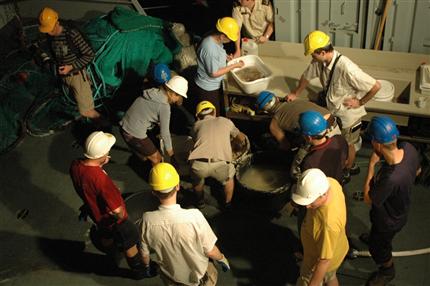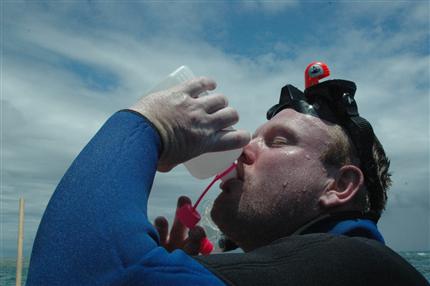Seasonal greetings.Newsletter 19: Now into its tenth leg, the Galathea expedition has reached the Solomon Sea north east of Australia. VÆDDEREN’s crew, scientists and educators will be spending the holiday period here.
Dato 21.12.2006
But researchers from the Zoological Museum work on, with investigations by a 16-strong team in full swing. Their interest lies in the ocean fauna at the continental shelf sea bed. Their catches include both large and small organisms: fish, polychaeta (annelid or bristle worms) and so-called meiofauna – benthic (living close to the floor of a body of water) animals whose sizes ranges from 0.2 to 1 mm. Scientific information, even on macrofauna (1mm and over), is sparse when looking beyond depths of 100m in the Solomon Sea. The meiofauna in the area are completely unknown. The ‘Benthic fauna’ project involves retrieving sediment samples with various kinds of equipment at depths of between 400- 600 m and as far as 4,000 metres.
The project keeps a diary and pictures of their samples can be seen at the Zoological Museum website. There is a film of the first haul using the large shrimp net, which had been cast at 2,300 metres. Politiken link (in Danish).

Foto: Anne Sofie Berendt
The quarterdeck at 05.00 hours in the morning. The Zoological Museum’s Benthic Fauna project has just hauled in its catch.....
Searching for the light sea creature
Professor Peter Roepstorff from Syddansk Universitet leads another new project on board VÆDDEREN: ‘Fluorescent proteins’. His mission is to find animals and plants which fluoresce green when exposed to blue light. This project is closely connected to industrial applications, including medical research. Fluorescent properties can be introduced into medical treatments, allowing a study with UV rays to highlight parts of the body and establish whether the treatment is successfully targeted.
Two other researchers from this project have been transferred to the Solomon Islands, where they will be diving for a couple of weeks. They expect to collect corals, sea anemones and other exciting creatures which may contain fluorescent proteins.
More can be found on this project by following this link.
News from the ornithologists
As VÆDDEREN sails her course, six ornithologists, also from the Zoological Museum, have been on the islands for some weeks. They have encountered, amongst other things, the Melanesian Scrubfowl (Megapodius eremita), one of the world’s most primitive birds and thought to have changed very little since the time of the dinosaurs; the rare Sanford's Fish-eagle (Halieeatus sanfordi) which may only be found on the Solomon Islands; the large, beautiful and extremely rare Yellow-legged Pigeon (Columba pallidiceps) and the critically endangered Cinnamon-bellied imperial pigeon (Ducula brenchley). The Danish paper Jyllands-Posten’s Galathea 3-web features this project. More can be found by following this (danish) link.

Foto: Anne Sofie Berendt
40 degrees on the quarterdeck.
Christmas at sea
Christmas Eve will be spent in the Solomon Islands. The chance of a white Christmas is many, many miles away. The thermometer on the quarterdeck has eased itself into the 40s. “Perspiration is pouring off us as if we were running a marathon in the Sahara," writes one of the Zoological Museum expedition members.
VÆDDEREN, nonetheless, has a seasonal feeling and wishes everyone a Happy Christmas!

Foto: Anne Sofie Berendt
|